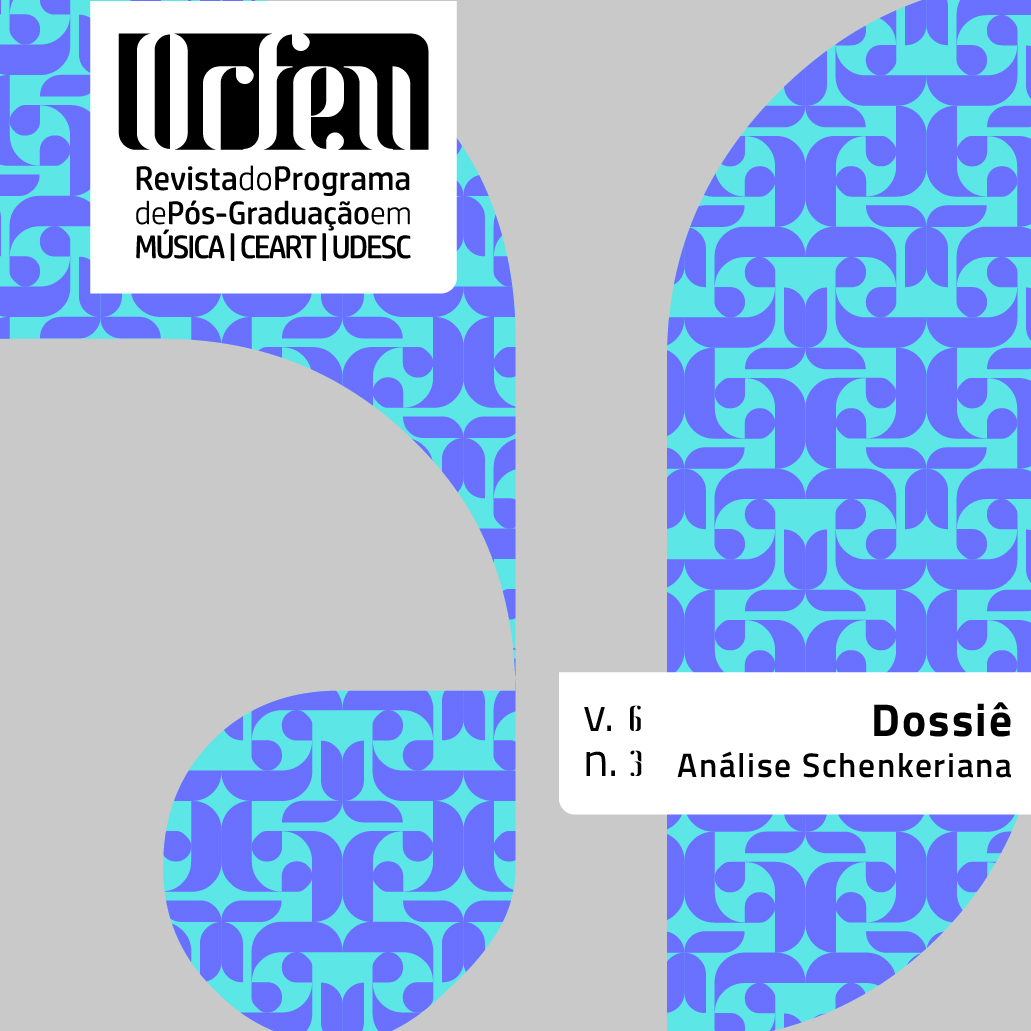A Arte de Modular, Preludiar e Fantasiar: o pensamento de Schenker sobre tonalidade e modulação reconsiderado
DOI:
https://doi.org/10.5965/2525530406032021032Palavras-chave:
Heinrich Schenker, Ludwig van Beethoven, Modulação, Prelúdio, FantasiasResumo
Embora Heinrich Schenker certamente tenha mudado de ideia sobre muitos tópicos, ele nunca renunciou à sua crença de que 1) as formas correntes de explicar a modulação eram fundamentalmente falhas; e 2) que a modulação é melhor aprendida improvisando prelúdios e fantasias. Para explicar esses pontos, a Parte I reconsidera a crítica de Schenker do Beiträge zur Modulationslehre de Max Reger (1903) e Die Kunst zu Modulieren und zu Präludieren de Salomon Jadassohn (1906): 1) reinterpretação [diatônica]; 2) cromaticismo; e 3) enarmonismo. A Parte II mostra como Schenker não apenas dispensou os conceitos tradicionais de tonalidades relativas, próximas e distantes, mas finalmente propôs que as modulações emergem no nível frontal (foreground) por razões contrapontísticas, até mesmo motívicas. Finalmente, a Parte III usa as afirmações de Schenker sobre modular e preludiar para analisar os “Dois Prelúdios” de Beethoven em Dó Maior, Op. 39, os quais modulam “através de todas as doze tonalidades principais.”
Downloads
Referências
BACH, C.P.E. Versuch über die wahre Art das Clavier zu spielen. Berlin: Winter, 1759, 1762. Tr. by W. MITCHELL as Essay on the True Art of Playing Keyboard Instruments. London: Eulenburg, 1974.
BLUMRÖDER, C. 1972. Modulatio / Modulation. In Handwörterbuch der musikalischen Terminologie, ed. by H. EGGEBRECHT, v.4, p.1-20, 1983.
BROWN, M, HEADLAM, D., DEMPSTER, D. The ♯IV(♭V) Hypothesis: Testing the Limits of Schenker’s Theory of Tonality. Music Theory Spectrum, v.19, n.2, p.155–183, 1997.
CAEYERS, J. Beethoven: A Life, tr. by B. ANNABLE. Berkeley, CA: University of California Press, 2020.
COOK, N. The Schenker Project. Oxford: Oxford University Press, 2007.
CZERNY, C. “Recollections from My Life” [1842], tr. E. SANDERS, The Musical Quarterly, v. 42, n.3, p.302-317, 1956.
GJERDINGEN, R. Music in the Galant Style. New York: Oxford University Press, 2007.
GREEN, J. F. New Hess Catalog. West Newberry, VT: Vance Brook Publishing, 2003.
HINTERBERGER, H. Enthaltend die Bibliothek des Herrn Dr. Heinrich Schenker. Wien Katalog XII. Vienna: Antiquariat Hinterberger, 1935.
JADASSOHN, S. Die Kunst zu Modulieren und zu Präludieren. Leipzig: Breitkopf und Härtel, 1890.
JADASSOHN, S. Lehrbuch der Harmonie. Leipzig: Breitkopf & Härtel, 1883.
JONAS, O. Das Wesen des musikalischen Kunstwerks: Einführung in die Lehre Heinrich Schenkers. Vienna: Saturn-Verlag, 1934. Ed. and tr. by J. ROTHGEB as Introduction to the Theory of Heinrich Schenker. New York: Longman, 1982.
LAUFER, E. On the Fantasy. Intégral v.2, p.99-133, 1988.
LOUIS, R.; THUILLE, L. Harmonielehre. Stuttgart: Carl Grüninger Verlag, 1907.
MITCHELL, W. J. Modulation in C.P.E. Bach’s Versuch. In Studies in Eighteenth-Century Music, ed. H.C. ROBBINS LANDON and R.E. CHAPMAN. London: George Allen, p.333-342, 1970.
QUANTZ, J.J., Versuch einer Anweisung die Flöte traversiere zu spielen. Berlin: Voss, 1752. Tr. by E. R. REILLY as On Playing the Flute. New York: Schirmer, 1985.
RASCH, R. The Musical Circle: From Alfonso to Beethoven. The Dutch Journal of Music Theory v.2, n.2, p.110-133, 1997.
RINK, J. Schenker and Improvisation. Journal of Music Theory v.37, n.1, p.1-54, 1993.
REGER, M. Beiträge zur Modulationslehre. Leipzig: C. Kahnt, 1903.
SALZER, F. Haydn’s Fantasia from the String Quartet, Opus 76, No. 6. The Music Forum 4, p.161-194, 1976.
SCHACHTER, C. Analysis by Key: Another Look at Modulation. Music Analysis 6/3 (1987), pp.289–318.
SCHENKER, H. Harmonielehre. Stuttgart and Berlin: Cotta, 1906. Tr. by E. MANN-BORGESE and ed. by O. JONAS as Harmony. Chicago: Chicago University Press, 1954.
SCHOENBERG, A. Structural Functions of Harmony. Rev. ed. Leonard Stein. New York: W. W. Norton, 1969.
SCHOENBERG, A. Kontrapunkt I. Stuttgart and Berlin: Cotta, 1910. Ed. John Rothgeb and tr. J. ROTHGEB and J. THYM as Counterpoint. Ann Arbor, MI: Musicalia, 2001.
SCHOENBERG, A. Die Kunst der Improvisation. In Das Meisterwerk in der Musik v.I. Munich: Drei Masken Verlag, p.11–40, 1925. Tr. by R. KRAMER as The art of improvisation. In The Masterwork in Music v.1, ed. by W. DRABKIN. Cambridge: Cambridge University Press, 2–19, 1994.
SCHOENBERG, A. Ein Gegenbeispiel: Max Reger, Op. 81, Variationen und Fuge über ein Thema von Joh. Seb. Bach für Klavier. In Das Meisterwerk in der Musik v.II. Munich: Drei Masken Verlag, p.173-192, 1926. Tr. by J. ROTHGEB as A counter-example: Max Reger’s Variations and Fugue on a Theme by Bach, Op. 81, for piano. In The Masterwork in Music v.1, ed. by W. DRABKIN. Cambridge: Cambridge University Press, p.106-117, 1994.
SCHOENBERG, A. Der freie Satz. Neue musikalische Theorien und Phantasien 3. Vienna: Universal, 1935. Tr. by E. OSTER as Free Composition. New York: Longman, 1979.
SOLOMON, M. Beethoven’s Productivity at Bonn. Music and Letters, v.53, n.2, p.165-172, 1972.
SWAFFORD, J. Beethoven: Anguish and Triumph. New York: Houghton Mifflin, 2014.
WASON, R. W.; BROWN, M. Heinrich Schenker’s Conception of Harmony. Rochester, NY: University of Rochester Press, 2020.
Downloads
Publicado
Como Citar
Edição
Seção
Licença
Copyright (c) 2021 John Koslovsky, Matthew Brown

Este trabalho está licenciado sob uma licença Creative Commons Attribution 4.0 International License.






